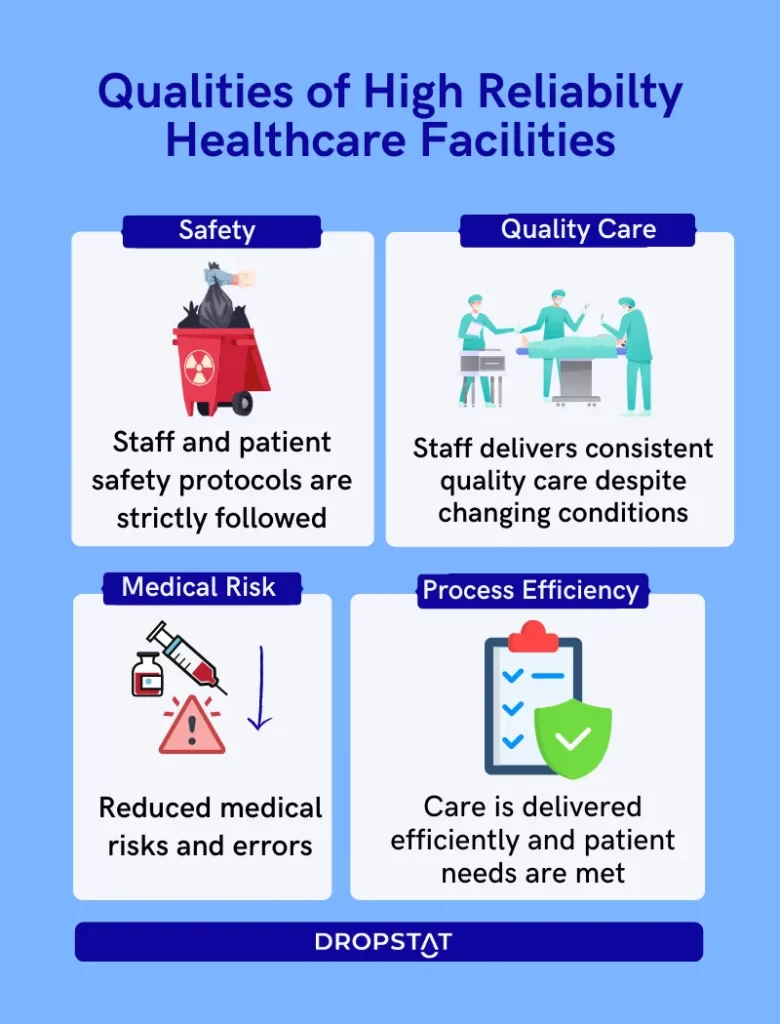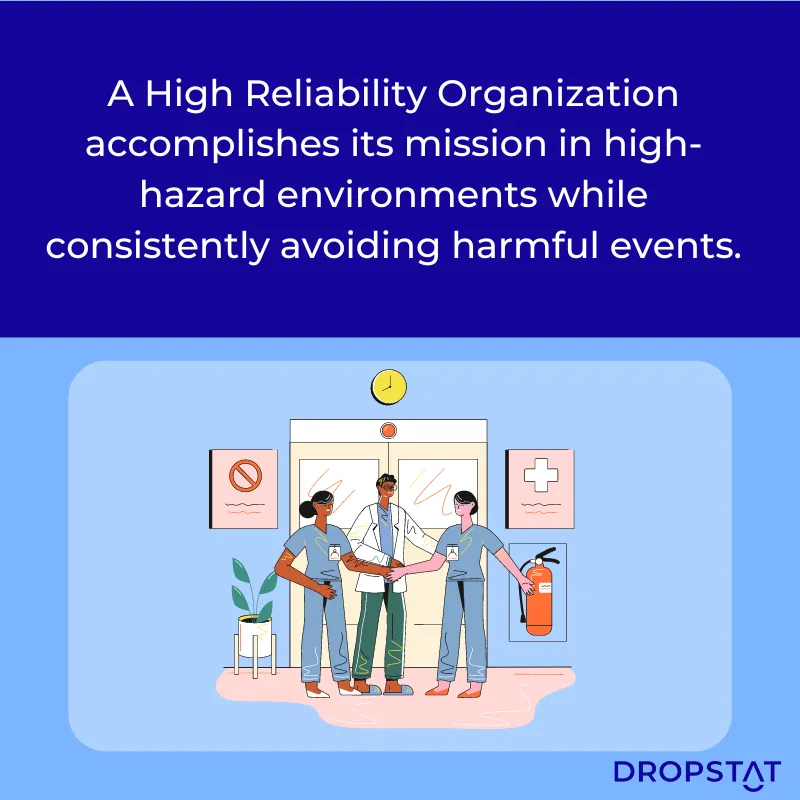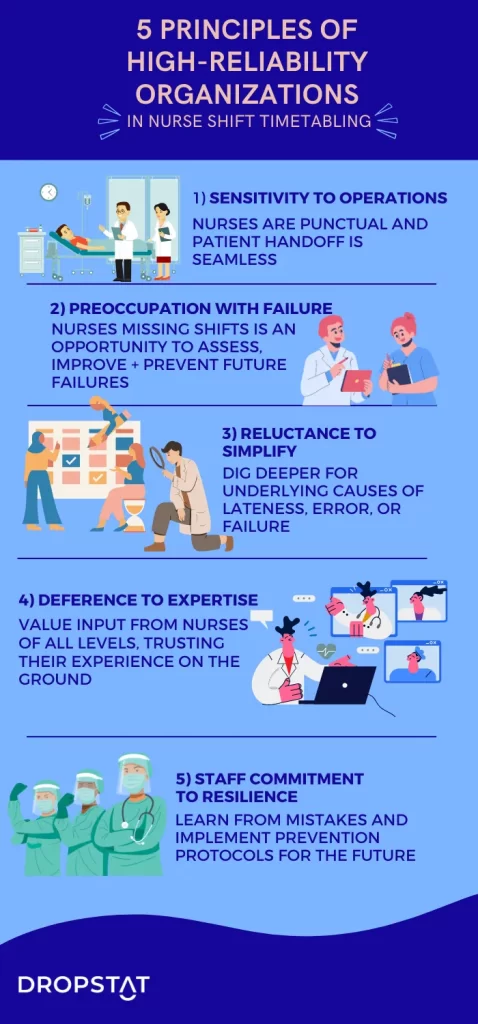Patients and their families expect large hospitals and healthcare organizations of all types to provide the safest care despite being high-risk environments. How can they achieve this? The concept of high-reliability organizations (HROs) originated in the naval aviation and nuclear power industries and has positively impacted the healthcare world. HRO principles have greatly enhanced healthcare’s ability to provide higher-quality care with fewer accidents than could be anticipated.
What is a high reliability organization?
A high reliability organization is a healthcare organization that accomplishes its mission in high-hazard environments and complex situations while maintaining its record for avoiding accidents or harmful events. Healthcare organizations can be called HROs when they achieve superlative
- safety for staff and patient satisfaction,
- consistent, quality care delivery under changing conditions, and,
- process efficiency
- for extended periods,
- without serious failures, and,
- with a lower risk of medical errors.

High reliability organizations are places where healthcare consumers feel secure despite the high-risk nature of the event. Routine anesthesia is an example of a high-risk event that is considered very reliable because there is a highly reliable healthcare strategy surrounding the event.
Examples of high reliability organizations that implemented HRO principles
High reliability in Michigan hospitals
In 2015, Michigan hospitals began their journey to high reliability by teaming up with the Joint Commission and the MHA Keystone Center. For 3 years, they focused on achieving
- zero harm to patients and their families
- zero harm to caregivers, and,
- attaining the status of high reliability for Michigan healthcare providers.
By 2019, the University of Michigan Hospital, Michigan Medicine in Ann Arbor was among 21 Michigan hospitals to rank in the U.S. News Best Hospital list.
High reliability in the U.S. Veteran’s Health Administration
The Veterans Health Administration (VHA) announced its efforts in patient safety from the 1990s onwards. The National Center for Patient Safety (NCPS), which is linked with the VHA, initiated an HRO strategy that gradually enveloped the entire enterprise with the goal of becoming a high-reliability organization. The commitment to continuous improvement is being written into law with a bill named the H.E.A.L.T.H. Act of 2023.
Establishing high reliability at Houston Methodist
Robert A. Phillips, MD, Ph.D., reflects on the progress made by Houston Methodist in becoming a high reliability organization and asks, “How can we continue to do this when we are not in a crisis mode?” Being open to learning and partnering with the bodies that direct quality improvement certainly helps to bring in a robust process improvement culture. For example, the Houston Methodist Hospital implemented a sepsis-prevention program in 2006. By 2021, sepsis-associated inpatient deaths decreased from 29.7% to 9.4%.
How to measure a health system’s progress in becoming an HRO
A high reliability healthcare organization measures levels of quality and patient safety in healthcare systems and processes over a period of time. One way of doing this is by using an online tool such as Oro (TM) 2.0, which has been tested and validated in 52 leading U.S. hospitals. In addition, HRO implementation strategies can be measured with the Safety Attitudes Questionnaire together with other surveys that are commonly run in healthcare organizations. Finally, many healthcare organizations use a review of healthcare literature, evidence review, and expert consensus to measure how much operational excellence a healthcare system has. Partnering with the Patient Safety Network, the Anesthesia Patient Safety Foundation, or the Joint Commission allows healthcare organizations to grow.

Dropstat discusses the importance of assessing healthcare performance with its article on evaluating quality metrics in healthcare.
The HRO meaning for nurse shift timetabling
Every high reliability healthcare organization can benefit from nurse shift timetabling with tools such as Dropstat. Timetabling is one powerful strategy that healthcare systems use to manage nursing staff and ensure that every shift has an HPPD-compliant number of nurses working in every shift.
Effective automated scheduling for nurses helps healthcare organizations
- maintain high levels of patient safety in high-risk situations, and
- avoid scheduling errors,
- while saving planning time and resources.
What are the 5 principles of high reliability organizations in nurse shift timetabling?
Weick, Sutcliffe, and Obstfeld (1999) investigated how using the principles of high reliability organizations in healthcare organizations would give healthcare an understanding of working with “effectiveness under trying conditions.” The 5 principles of a highly reliable organization, as seen from the Dropstat angle, demonstrate how nurse shift timetabling is acutely important to the journey of a healthcare organization to become a high reliability organization.
The 5 principles of high reliability organizations as they are enabled through efficient timetabling:
1. Sensitivity to Operations
The principle: Staff are acutely aware of the systems in place in their healthcare organizations and understand the processes of safe patient care. Staff note risks and attempt to prevent harm.
The nurse timetable angle: Since nurses turn up on time, the handoff is effective, and shift transfer is an opportunity to share patient care experiences. All staff on each shift experience the health system and its learning episodes together.
2. Preoccupation With Failure
The principle: Near-misses are viewed as indicators of potential to improve patient safety.
The nurse timetable angle: Nurses are always present for every scheduled shift. No call no show by nurses is viewed as an opportunity to examine why a nurse missed their shift and how to improve intra-staff communications to prevent it from happening again, coming from a blame-free, constructive direction.
3. Reluctance to simplify
The principle: Being truly accountable means digging deep to avoid overly simple justifications for why things fail.
The nurse timetable angle: Many underlying problems develop as a knock-on effect of nurses being overworked or stressed due to poor timetabling in healthcare organizations.

4. Deference to expertise
The principle: High reliability is possible when the staff of all levels listen to each other, respecting nurses who might be lower on the nursing hierarchy but understand processes better.
The nurse timetable angle: A high reliability organization commits to ensuring that nurses with the correct level of qualification are present at every shift, subject to patient acuity in any particular shift. Staff of all disciplines and levels intermingle and communicate. Providing the right staff resources is a powerful way to achieve zero harm.
5. Staff commitment to Resilience
The principle: Many catastrophes are unpredictable system failures. Staff must practice rapid response to failures.
The nurse timetable angle: By digitizing and automating nurse timetabling, you will always have a record of which staff was on duty during any particular event. This leads to greater accountability and clarity in where staff can improve through training and education.
Dropstat: A leading resource for high reliability organizations in healthcare
Dropstat is a leading AI-powered nurse scheduling app that has helped many large healthcare organizations improve nurse scheduling practices. By boosting nurse scheduling practices through Dropstat’s app and building up intra-staff communication through Dropstat’s secure internal chat system, failures can be minimized, examined, and learned from. Dropstat is an ideal tool to help your healthcare organization proceed confidently on its journey to becoming a high reliability organization.
Schedule a demo with Dropstat today to experience how effective nurse timetabling can help your healthcare organization become a high reliability organization.







